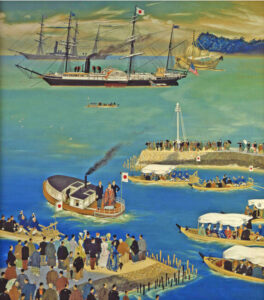About the Special Exhibit
About the Special Exhibit Welcome to the Ilwakura Mission Exhibit, a project of the Digital Museum of the History of Japanese in New York. The project recognizes the 150th anniversary of the lwakura Mission‘s 1871 departure from Japan, a pivotal moment in the country’s development of international presence. The lwakura Mission is a cornerstone of Japan’s modern history.
We welcome you to explore the tabs above to dive into elements of the exhibit, or continue to scroll for an overview of the mission and a timeline of the delegates’ journey.
Notes:
- The Iwakura Mission has been identified at various points by different monikers. As such, this exhibit may use the terms “mission”, “embassy”, “delegation”, and others interchangeably when context allows.
- In the English version of this exhibit, Japanese names are listed given name first, followed by surname (e.g. 岩倉具視 = Tomomi lwakura).
- All maps on display in the exhibit have been sourced from the David Rumsey Map Collection, David Rumsey Map Center, Stanford Libraries.
The lwakura Mission

In the mid-nineteenth century, after a prolonged period of relative isolation, Japan resumed trade with much of the outside world. This shift to a more globalized commerce resulted in dramatic changes within Japan, and eventually throughout the world — its significance building so much as to partly cause the formation of a new Japanese government in the late 1860s.
Under the previous Shogunate governance, diplomatic missions had visited the United States in 1860, and Europe in 1862 and 1863. The new Meiji government had modernized objectives for its own diplomatic visit and created the The Ilwakura Mission, also called the lwakura Embassy, to undertake an expedition from 1871 to 1873. Roughly 50 members of the government participated, journeying to the United States, United Kingdom, France, Germany, and several other countries.
At the time, many Japanese administrators were frustrated by their relationship with Western nations, feeling exploited economically and politically. The lwakura Mission was dispatched as a means to better understand the political, military, economic, and educational institutions of the United States and Europe, with hopes to amend the history of unequal treaties and re-establish Japan on the world stage.
This exhibition provides an overview of the entire two-year Iwakura Mission. There is a special emphasis on the several months that the delegates spent traveling through the Eastern United States, highlighting their negotiations, meetings with American dignitaries, and visits to some of the most significant historical sites.
Special Thanks
Research Contributors
- Suchisman Gangopadhyay
- Emily Ren
- Xiaoke Yang
- David Zarowin
Article Contributors
- Suchisman Gangopadhyay
- Xiaoke Yang
- David Zarowin
“Rutgers and the lwakura Mission”
- Professor Haruko Wakabayashi
Copyeditor
- Meleah Moore
Translators
- Eiko Aono
- Kazato Ito
- Yoshiko Oishi
- Sora Sato
- Akemi Takeda
- Izumi Ueda
Institutions
- Bryn Mawr College
- Kume Museum of Art
- Meiji Memorial Picture Gallery
- Rutgers University
- Tsuda University
- Vassar University
